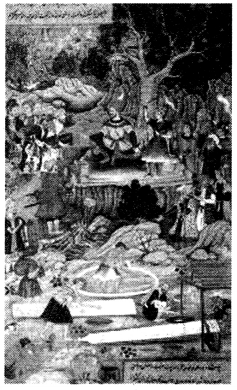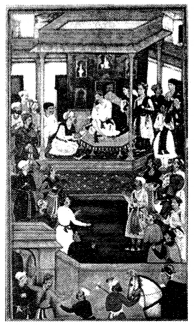Do you need some help in preparing for your upcoming Class 12 History exam? We’ve compiled a list of MCQ questions on Peasants, Zamindars and the State Class 12 MCQs Questions with Answers to get you started with the subject. You can download NCERT MCQ Questions for Class 12 History Chapter 8 Peasants, Zamindars and the State: Agrarian Society and the Mughal Empire with Answers Pdf free download, and learn how smart students prepare well ahead MCQ Questions for Class 12 History with Answers. Start your preparation with MCQ on Peasants, Zamindars and the State Class 12 Objective Questions.
Peasants, Zamindars and the State Class 12 MCQs Questions with Answers
Question 1.
What was the basic unit of agricultural society?
(a) State
(b) City
(c) Town
(d) Village
Answer
Answer: (d) Village
Question 2.
Which of the following crops was introduced into India via Africa and Spain?
(a) Chillies
(b) Maize
(c) Papaya
(d) Tomatoes
Answer
Answer: (b) Maize
Question 3.
Who was the author of Ain-i-Akbari?
(a) Akbar
(b) Abul Fazl
(c) Ibn Batuta
(d) Abdur Razzaq
Answer
Answer: (b) Abul Fazl
Question 4.
Which of the following were the duties performed by state officials in the 16th century?
(a) Collection of land revenue
(b) Measuring the land
(c) Keeping the records
(d) All the above
Answer
Answer: (d) All the above
Question 5.
Which of the following crops were considered as jins-i-Kamil?
(a) Cotton and sugarcane
(b) Maize and sugarcane
(c) Rice and wheat
(d) Chillies and potatoes
Answer
Answer: (a) Cotton and sugarcane
Question 6.
Which of the following statements regarding the roles played by women in agrarian society is incorrect?
(a) Women sowed, weeded, threshed, and winnowed the harvest.
(b) Women worked shoulder to shoulder with men in fields.
(c) During some days of the month women were not allowed to touch the plough.
(d) Women took the produce to the overseas markets for trade.
Answer
Answer: (d) Women took the produce to the overseas markets for trade.
Question 7.
What do you understand by the term Khud-Kashta?
(a) Peasants who were residents of the village
(b) Non-resident cultivators
(c) Revenue collectors
(d) Head of jati panchayat
Answer
Answer: (a) Peasants who were residents of the village
Question 8.
Which of the following crops was banned by Jahangir?
(a) Betel leaf
(b) Chillies
(c) Tobacco
(d) Maize
Answer
Answer: (c) Tobacco
Question 9.
What was the village headman called?
(a) Muqaddam
(b) Asarrii
(c) Muzarian
(d) Riaya
Answer
Answer: (a) Muqaddam
Question 10.
Which of the following Muslim community was considered menial?
(a) Mandal
(b) Halalkhoran
(c) Majur
(d) Jangli
Answer
Answer: (b) Halalkhoran
Question 11.
Name any two Jins-i-Kamil crops.
Answer
Answer: Cotton and sugarcane are two Jins-i-Kamil crops.
Question 12.
Give one point of difference between Khud- Kashta and Pahi-Kashta?
Answer
Answer: Khud-Kashta were the peasants who lived in the village which they cultivated themselves. Pahi-Kashta were the peasants who lived in some other village and cultivated lands elsewhere on a contractual basis.
Question 13.
Find out from the following pairs which one is not correctly matched:
(a) Kharif : Autumn
(b) Rabi : Spring
(c) Makka : Maize
(d) Muqaddam : Labourer
Answer
Answer: (d) Muqaddam: Labourer
Question 14.
Indicate which of the following statements is NOT correct.
(a) Jati Panchayat arbitrated civil disputes between members of different castes.
(b) The state respected the decisions of jati panchayat in matters related to criminal justice.
(c) Jati Panchayat mediated in contested claims on the land.
(d) Milkiyat as the extensive personal lands held by the zamindars.
Answer
Answer: (b) The state respected the decisions of jati panchayat in matters related to criminal justice.
Question 15.
Match the following.
| (i) Headman | (a) Village accountant |
| (ii) Patwari | (b) Begar |
| (iii) Labour | (c) Kharbandi |
| (iv) Scrubland | (d) Mandals |
Choose the correct option.
(a) i – b, ii – c, iii – a, iv – d
(b) i – c, ii – a, iii – b, iv – d
(c) i – c, ii – d, iii – b, iv – a
(d) i – d, ii – a, iii – b, iv – c
Answer
Answer: (d) i – d, ii – a, iii – b, iv – c
Question 16.
Look at the given painting and describe it.

Answer
Answer: It is a seventeenth-century painting depicting textile production.
Question 17.
Look at the given painting and describe it.

Answer
Answer: This painting depicts Abu’l Fazl presenting the manuscript of the completed Akbar Nama to his patron.
Question 18.
An administrative subdivision of a Mughal painting is called _________
Answer
Answer: Pargana
Question 19.
_________ was a form of tribute collected by the Mughal state.
Answer
Answer: Peshkash
Question 20.
Consider the following statements regarding the classification of lands under Akbar.
(i) Polaj is land which is annually cultivated for each crop in succession and is never allowed to lie fallow.
(ii) Chachar is land uncultivated for five years and more.
(iii) Parauti is land left out of cultivation for a time that it may recover its strength.
Which of the following statements is/are correct?
(a) i and iii
(b) ii and iii
(c) i and ii
(d) iii only
Answer
Answer: (a) i and iii
Question 21.
Read the information given below:
Identify and name the administrative system.
| The Mughal administrative system had at its apex a military-cum-bureaucratic apparatus which was responsible for looking after the civil and military affairs of the state. |
Answer
Answer: Mansabdari system
Question 22.
Arrange the following events in chronological order:
1. Ahmad Shah Abdali defeated the Marathas
2. Bahadur Shah II deposed and exiled to Rangoon
3. Nadir Shah invaded India
4. Humayun regained lost territories
Choose the correct option:
(a) 4, 3, 1, and 2
(b) 4, 1, 2, and 3
(c) 3, 4, 1, and 2
(d) 1, 2, 3 and 4
Answer
Answer: (a) 4, 3, 1, and 2
We hope you found this CBSE Class 12 History Peasants, Zamindars and the State MCQs Multiple Choice Questions with Answers helpful. If you have any questions about NCERT MCQ Questions for Class 12 History Chapter 8 Peasants, Zamindars and the State: Agrarian Society and the Mughal Empire with Answers Pdf free download, please share them in the comment box below and we will get back to you at the earliest possible time.